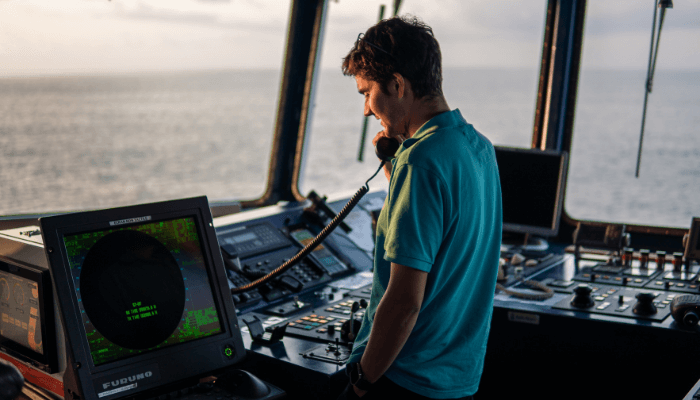What are SSB Radios?
SSB radio is used by boats or yachts for communication at sea. It is part of the Global Maritime Distress, and Safety System established under SOLAS, the international convention for the safety of life at sea.
The full form of SSB Marine radio is Single Side Band radio. The SSB radios offer quick access to over 700 radio channels. MF or medium frequency SSB radios range about 400 nautical miles, while HF or high-frequency SSB radios range a thousand miles.
Hence, they have a larger reach than VHF radios, ranging from 35 to 50 nautical miles. The system consists of chargeable lithium-ion batteries, chargers, an external antenna, and an automatic antenna tuner and is used by sailors, mariners and naval forces.
The State of California declared that these batteries contain certain cancer-causing chemicals and should be handled cautiously. While charging the radio system, one should place it on a fire-proof surface and not leave it unattended for a long time. Also, good quality cable connections should be installed for greater transmission clarity.
While many believe that a satellite phone may come in handy during emergencies, an SSB radio with marine SSB transceivers is the most helpful tool since it sends distress signals to all ships in the vicinity and alerts the rescue authorities automatically. In contrast, you can call just one number through a satellite phone. Also, pairing the SSB radio with a Pactor modem would allow one to receive weather faxes, weather GRIB Data and e-mails onboard a vessel.
Depending on the requirement, one can opt for SSB amateur radio systems cheaper than SSB Marine radios. However, an amateur radio certificate is more difficult to get than a marine radio license or a Long Range Certificate. Also, the expensive SSB marine radios have a DSC or Digital Selective Calling function too.
The SSB radio was first used as a part of the navigational radio system after World War II. The main reason for introducing the SSB radio system was the problems caused by the AM (Amplitude Modulation) radio system.
One of the main disadvantages or problems of the AM radio system was that it absorbed a considerable amount of unwanted power and space. Also, the AM system was not foolproof. The messages and information passed through the AM system could be listened to and monitored by unwanted channels leading to important information being passed on and emergencies being created.
The SSB radios offer a wide variety of services like a two-way communication marine radio system with the captains of other boats, yachts and the coast guards. Apart from this, the SSB radios are not affected by distance. They can be easily used for calls and messages between yachts or boats far away from each other without disrupting or distorting transmission. In addition to being a marine radio system that offers full-proof communication channels, the SSB radio system also provides entertainment in the form of music to the boat’s crew. The SSB radio thus provides a comprehensive marine radio communication system to the shipping industry.
However, a specific transmitter must be equipped in the boat to receive and send messages through an SSB radio system. If this transmitter is not fixed to the ship, then routine radio communication transmitters like the AM radio channel would be used for receiving the SSB radio signals. The voice modulation in AM radio frequency channels will be vastly different because of the difference in the transmitting channels. This could make the messages distorted, leading to further confusion and chaos.
The appropriate systems that need to be used to read the messages sent via the SSB radio system correctly are the Beat Frequency Oscillator (BFO) or the Carrier Insertion Oscillator (CIO). The system of SSB radios is a significant development in the field of radio communication. This development will only increase in the days to come, helping the seamen navigate and communicate even more effectively than ever before.
Frequently Asked Questions
1. Is SSB the same as HAM Radios?
HAMS make use of the same kind of SSB but on HAM Frequencies. The coast guard uses frequencies on marine channels. However, in case of an emergency, they can also call out to all ham radio operators on ham frequencies.
2. How far can you talk on an SSB Radio?
An SSB Distress call is sent to all ships within range, and the range can be thousands of miles. It is also sent to the nearest search and rescue services, depending on your location. On the other hand, a satellite call can be dialled to only one number.
3. What is an SSB Radio system?
SSB Marine Radio or Single Side Band Radio is used for communicating over very large distances without the requirement of any subscriptions or ongoing costs and tariffs. It is mainly like AM and FM.
4. What is the importance of SSB Radio onboard ships?
Apart from being a system that provides foolproof communication channels, ensuring the safety of vessels at sea, the SSB system also keeps the sailors entertained as one can tune in to various channels and hear music or even weather reports. Hence, it offers all-around communication services to the shipping sector.
5. Do you need a licence to use SSB Radio?
Yes, all two-way communication radios require a licence which depends on the type of radio one has. One can opt for SSB amateur radio systems which are cheaper than SSB Marine radios. However, an amateur radio certificate is more difficult to get than a marine radio license or a Long Range Certificate.
You might also like to read-
- A Brief Introduction to Survival Radios
- Obsolete-yet-Famous Marine Jobs: Radio Officers
- What Are Marine VHF Radios, Marine GPS and Marine Autopilots?
- Introduction to Global Maritime Distress Safety System (GMDSS) – What You Must Know
- What is Maritime Mobile Service Identity?
Disclaimer: The author’s views expressed in this article do not necessarily reflect the views of Marine Insight. Data and charts, if used, in the article have been sourced from available information and have not been authenticated by any statutory authority. The author and Marine Insight do not claim it to be accurate nor accept any responsibility for the same. The views constitute only the opinions and do not constitute any guidelines or recommendations on any course of action to be followed by the reader.
The article or images cannot be reproduced, copied, shared, or used in any form without the permission of the author and Marine Insight.
Do you have info to share with us ? Suggest a correction
Latest Marine Technology Articles You Would Like:
- 10 Harmful Effects Of Impure Air On Ship’s Machinery
- 10 Important Things to Check While Starting Fuel Oil Purifier on Ships
- 10 Noteworthy LNG-Powered Vessels
- 10 Points for Efficient Turbocharger Operation On Ships
- 10 Practical Tips to Handle Engine Room Pumps
- 10 Precautions to Take Before Operating Controllable Pitch Propeller (CPP) on Ships
Subscribe To Our Newsletters
By subscribing, you agree to our Privacy Policy and may receive occasional deal communications; you can unsubscribe anytime.
Web Stories

About Author
Zahra is an alumna of Miranda House, University of Delhi. She is an avid writer, possessing immaculate research and editing skills. Author of several academic papers, she has also worked as a freelance writer, producing many technical, creative and marketing pieces. A true aesthete at heart, she loves books a little more than anything else.






















I need scripts on ssb marine radio operation and settings journals
I’m looking for a beginner guideline about everything related to SSB radios, this article is perfect for me. Very helpful info.
@Robert – We are glad that the content we are producing is being used and considered helpful. Elated to read your comment 🙂